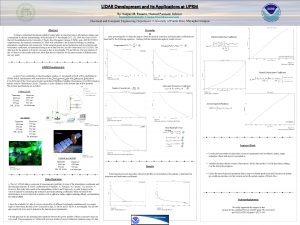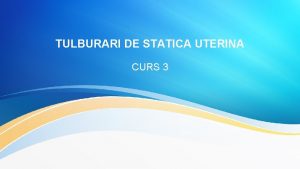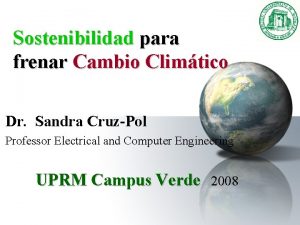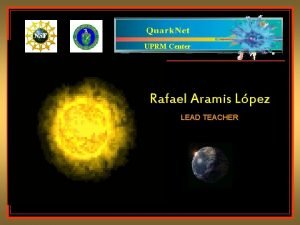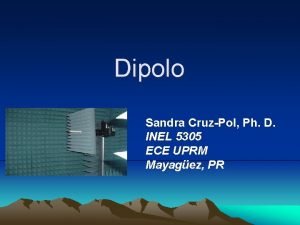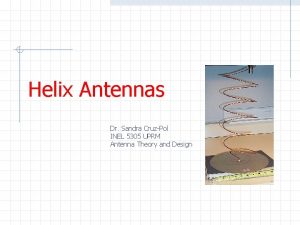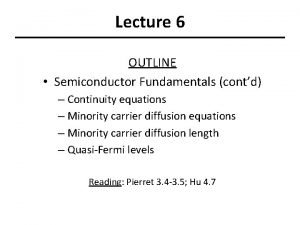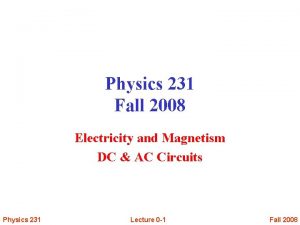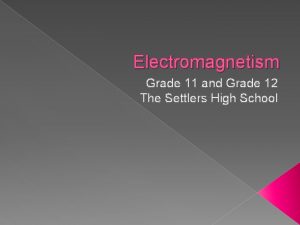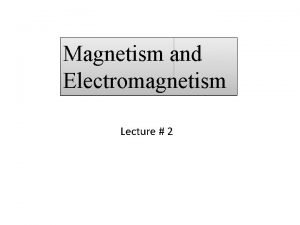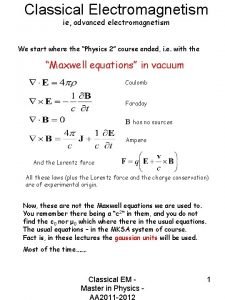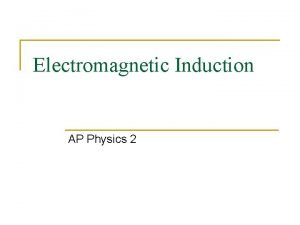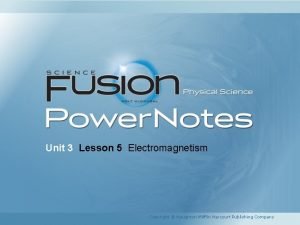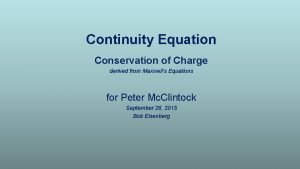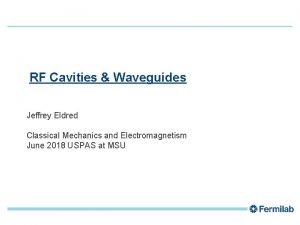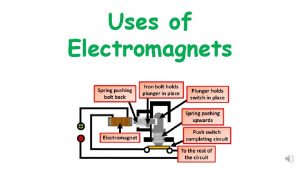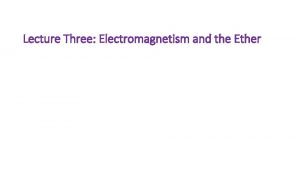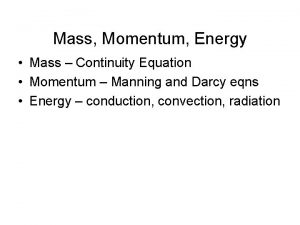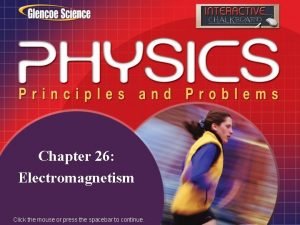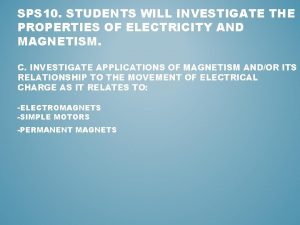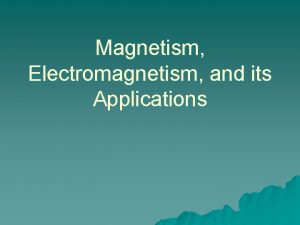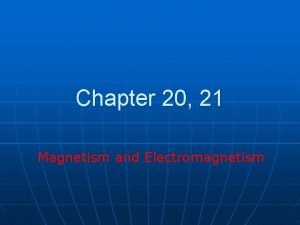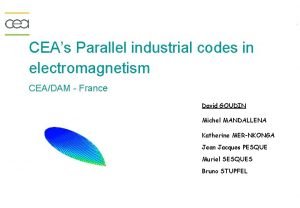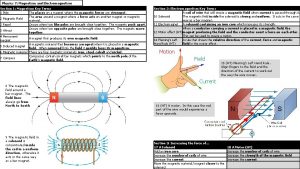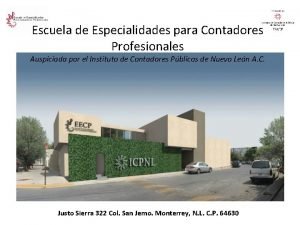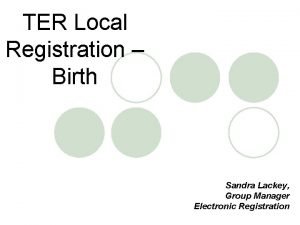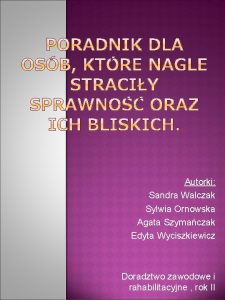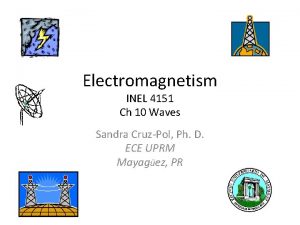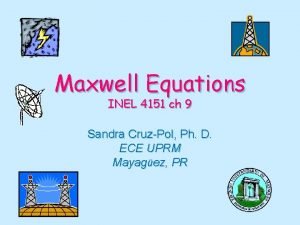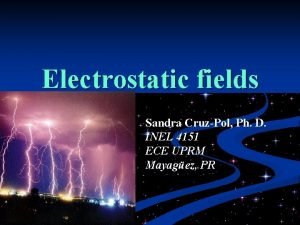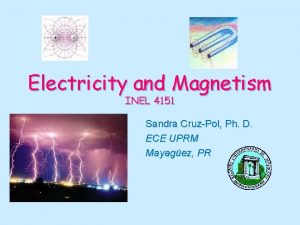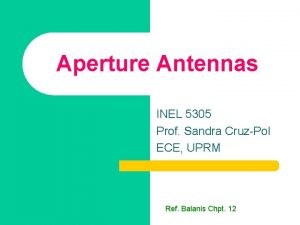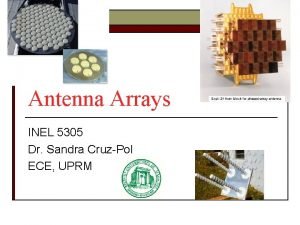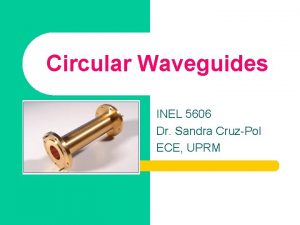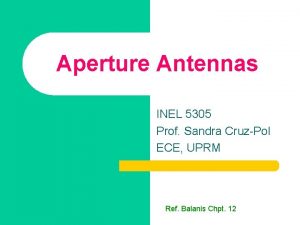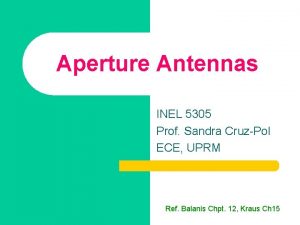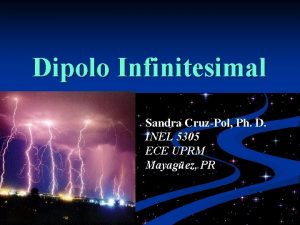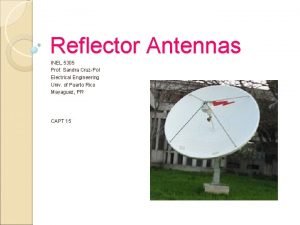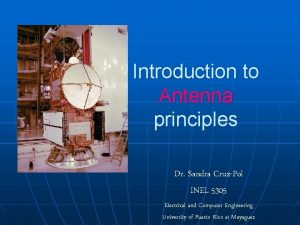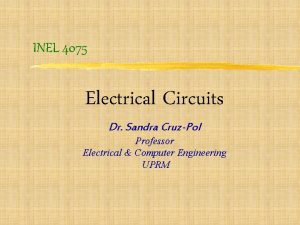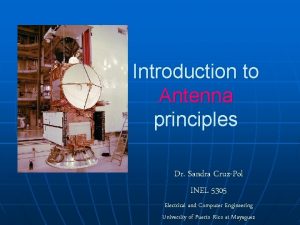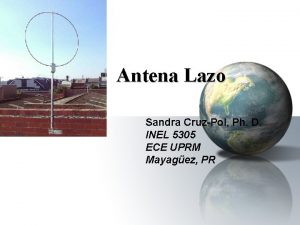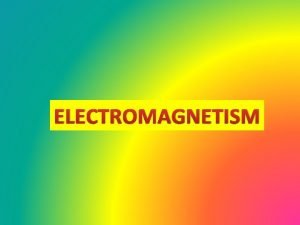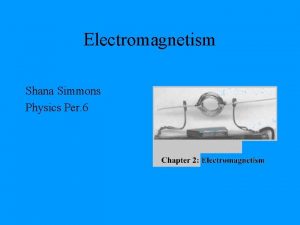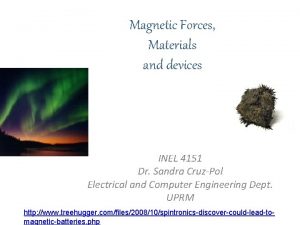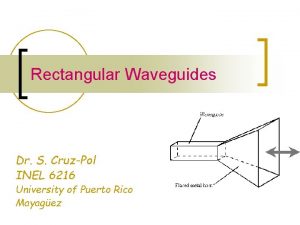Electromagnetism INEL 4151 Sandra CruzPol Ph D ECE




















![Summary of Terms Ø E = electric field intensity [V/m] Ø D = electric Summary of Terms Ø E = electric field intensity [V/m] Ø D = electric](https://slidetodoc.com/presentation_image_h2/5d59f06f9b25e5ee3aa5c2a83cd56bf8/image-21.jpg)























- Slides: 44

Electromagnetism INEL 4151 Sandra Cruz-Pol, Ph. D. ECE UPRM Mayagüez, PR

In summary Ø Stationary Charges l Q Ø Steady currents l E Ø Magnetostatic fields H I Ø Time-varying currents l Ø Electrostatic fields I(t) Ø Electromagnetic (waves!) l E(t) & H(t) Cruz-Pol, Electromagnetics UPRM

Outline Faraday’s Law & Origin of Electromagnetics Ø Transformer and Motional EMF Ø Displacement Current & Maxwell Equations Ø Review: Phasors and Time Harmonic fields Ø

9. 2 FARADAY’S LAW

Electricity => Magnetism Ø In 1820 Oersted discovered that a steady current produces a magnetic field while teaching a physics class. This is what Oersted discovered accidentally: Cruz-Pol, Electromagnetics UPRM

Would magnetism would produce electricity? Ø Eleven years later, and at the same time, (Mike) Faraday in London & (Joe) Henry in New York discovered that a time -varying magnetic field would produce an electric current! Cruz-Pol, Electromagnetics UPRM

Len’s Law = (-) Ø If N=1 (1 loop) Ø The time change can refer to B or S Cruz-Pol, Electromagnetics UPRM

Electromagnetics was born! Ø This is Faraday’s Law the principle of motors, hydro-electric generators and transformers operation. *Mention some examples of em waves Cruz-Pol, Electromagnetics UPRM

Faraday’s Law Ø For N=1 and B=0 Cruz-Pol, Electromagnetics UPRM

Example PE 9. 3 A magnetic core of uniform cross-section 4 cm 2 is connected to a 120 V, 60 Hz generator. Calculate the induced emf V 2 in the secondary coil. N 1= 500, N 2=300 Ø Use Faraday’s Law Answer; 72 cos(120 pt) V

9. 3 TRANSFORMER & MOTIONAL EMF

Two cases of Ø B changes Ø S (area) changes Stoke’s theorem Cruz-Pol, Electromagnetics UPRM

Three (3) cases: Ø Stationary loop in time-varying B field Ø Moving loop in static B field Ø Moving loop in time-varying B field Cruz-Pol, Electromagnetics UPRM

Example + V 1 __ R 1=300 W + V 2 _ R 2=200 y S= 0. 5 m 2 x The resistors are in parallel, but V 2≠V 1

PE 9. 1

Vemf variation with S Ø https: //www. youtub e. com/watch? v=i-j 1 j 2 g. D 28&feature=r elated Cruz-Pol, Electromagnetics UPRM

Transformer Example Ø Find reluctance and use Faraday’s Law Cruz-Pol, Electromagnetics UPRM

9. 4 DISPLACEMENT CURRENT, JD

Ø Maxwell noticed something was missing… And added Jd, the displacement current S 1 I L S 2 At low frequencies J>>Jd, but at radio frequencies both Cruz-Pol, Electromagnetics terms are comparable in magnitude. UPRM

9. 4 MAXWELL’S EQUATION IN FINAL FORM
![Summary of Terms Ø E electric field intensity Vm Ø D electric Summary of Terms Ø E = electric field intensity [V/m] Ø D = electric](https://slidetodoc.com/presentation_image_h2/5d59f06f9b25e5ee3aa5c2a83cd56bf8/image-21.jpg)
Summary of Terms Ø E = electric field intensity [V/m] Ø D = electric field density [C/m 2] Ø H = magnetic field intensity, [A/m] Ø B = magnetic field density, [Teslas] Ø J = current density [A/m 2] Cruz-Pol, Electromagnetics UPRM

Maxwell Equations in General Form Differential form Integral Form Gauss’s Law for E field. Gauss’s Law for H field. Nonexistence of monopole Faraday’s Law Ampere’s Circuit Law

Maxwell’s Eqs. Ø Also the equation of continuity Ø Maxwell added the term to Ampere’s Law so that it not only works for static conditions but also for time-varying situations. l This added term is called the displacement current density, while J is the conduction current. Cruz-Pol, Electromagnetics UPRM

Relations & B. C. Cruz-Pol, Electromagnetics UPRM

9. 6 TIME VARYING POTENTIALS

We had defined Ø Electric & Magnetic potentials: Ø Related to B as: Substituting into Faraday’s law: Identity: the curl of the gradient of a scalar = zero. . Choose V

Electric & Magnetic potentials: Ø If we take the divergence of E: Ø Or Ø Taking the curl of: we get Cruz-Pol, Electromagnetics UPRM & add Ampere’s

Electric & Magnetic potentials: Ø If we apply this vector identity Ø We end up with Cruz-Pol, Electromagnetics UPRM

Electric & Magnetic potentials: Ø We now use the Lorentz condition: To get: Which are both wave equations. and: Cruz-Pol, Electromagnetics UPRM

Who was Nikola. Tesla? Ø Find out what inventions he made Ø His relation to Thomas Edison Ø Why is he not well know?

9. 7 TIME HARMONIC FIELDS PHASORS REVIEW

Time Harmonic Fields Ø Definition: is a field that varies periodically with time. Example: A sinusoid Ø Let’s review Phasors! Cruz-Pol, Electromagnetics UPRM

Phasors & complex #’s Working with harmonic fields is easier, but requires knowledge of phasor, let’s review Ø complex numbers and Ø phasors Cruz-Pol, Electromagnetics UPRM

COMPLEX NUMBERS: Ø Given a complex number z where Cruz-Pol, Electromagnetics UPRM

Review: Ø Addition, Ø Subtraction, Ø Multiplication, Ø Division, Ø Square Root, Ø Complex Conjugate Cruz-Pol, Electromagnetics UPRM

For a Time-varying phase Real and imaginary parts are: Cruz-Pol, Electromagnetics UPRM

PHASORS Ø For a sinusoidal current equals the real part of Ø The complex term which results from dropping the time factor is called the phasor current, denoted by (s ( comes from sinusoidal) Cruz-Pol, Electromagnetics UPRM

To change back to time domain The phasor is 1. multiplied by the time factor, e jwt, 2. and taken the real part. Cruz-Pol, Electromagnetics UPRM

Advantages of phasors Ø Time derivative in time is equivalent to multiplying its phasor by jw Ø Time integral is equivalent to dividing by the same term. Cruz-Pol, Electromagnetics UPRM

9. 7 TIME HARMONIC FIELDS

Time-Harmonic fields (sines and cosines) Ø The wave equation can be derived from Maxwell equations, indicating that the changes in the fields behave as a wave, called an electromagnetic wave or field. Ø Since any periodic wave can be represented as a sum of sines and cosines (using Fourier), then we can deal only with harmonic fields to simplify the equations. Cruz-Pol, Electromagnetics UPRM

Maxwell Equations for Harmonic fields (phasors) Differential form* Gauss’s Law for E field. Gauss’s Law for H field. No monopole Faraday’s Law Ampere’s Circuit Law * (substituting Cruz-Pol, Electromagnetics ) UPRM and

Example Use Maxwell equations: Ø In Phasor form Ø In time-domain Cruz-Pol, Electromagnetics UPRM

Earth Magnetic Field Declination from 1590 to 1990 Cruz-Pol, Electromagnetics UPRM
 Uprm inel
Uprm inel Inel kayser-fleischer
Inel kayser-fleischer Uprm inel
Uprm inel Colporafia
Colporafia Uprm inel
Uprm inel Uprm inel
Uprm inel Uprm inel
Uprm inel Inel taylor
Inel taylor Uprm inel
Uprm inel Uprm inel
Uprm inel Anatomia topografica a membrului inferior
Anatomia topografica a membrului inferior Uprm inel
Uprm inel Continuity equation in semiconductor
Continuity equation in semiconductor Electromagnetism
Electromagnetism Electromagnetism cheat sheet
Electromagnetism cheat sheet Electromagnetism grade 11
Electromagnetism grade 11 A substance that attracts pieces iron
A substance that attracts pieces iron Khan academy
Khan academy Electromagnetism
Electromagnetism Displacement current and maxwell's equations
Displacement current and maxwell's equations Scrap yard crane electromagnet diagram
Scrap yard crane electromagnet diagram Application of faraday's law
Application of faraday's law Lesson 5 electromagnetism answer key
Lesson 5 electromagnetism answer key Continuity equation for charge
Continuity equation for charge Electromagnetism
Electromagnetism Electromagnetism uses
Electromagnetism uses Hans christian oersted electromagnetism
Hans christian oersted electromagnetism Electromagnetism
Electromagnetism Electromagnetic force
Electromagnetic force Equation of continuity
Equation of continuity Chapter 26 electromagnetism study guide answers
Chapter 26 electromagnetism study guide answers Electromagnetism
Electromagnetism Applications of magnetism
Applications of magnetism Methernitha
Methernitha Ceadam
Ceadam Magnetism and electromagnetism
Magnetism and electromagnetism Icpnl escuela de especialidades
Icpnl escuela de especialidades Sandra ivkovic
Sandra ivkovic Ruska petorka kompozitora
Ruska petorka kompozitora Sandra lackey
Sandra lackey Sandra mulaomerovic
Sandra mulaomerovic Sandra skupin
Sandra skupin Sandra keith hanevold
Sandra keith hanevold Barentsi meri
Barentsi meri Sandra walczak
Sandra walczak
